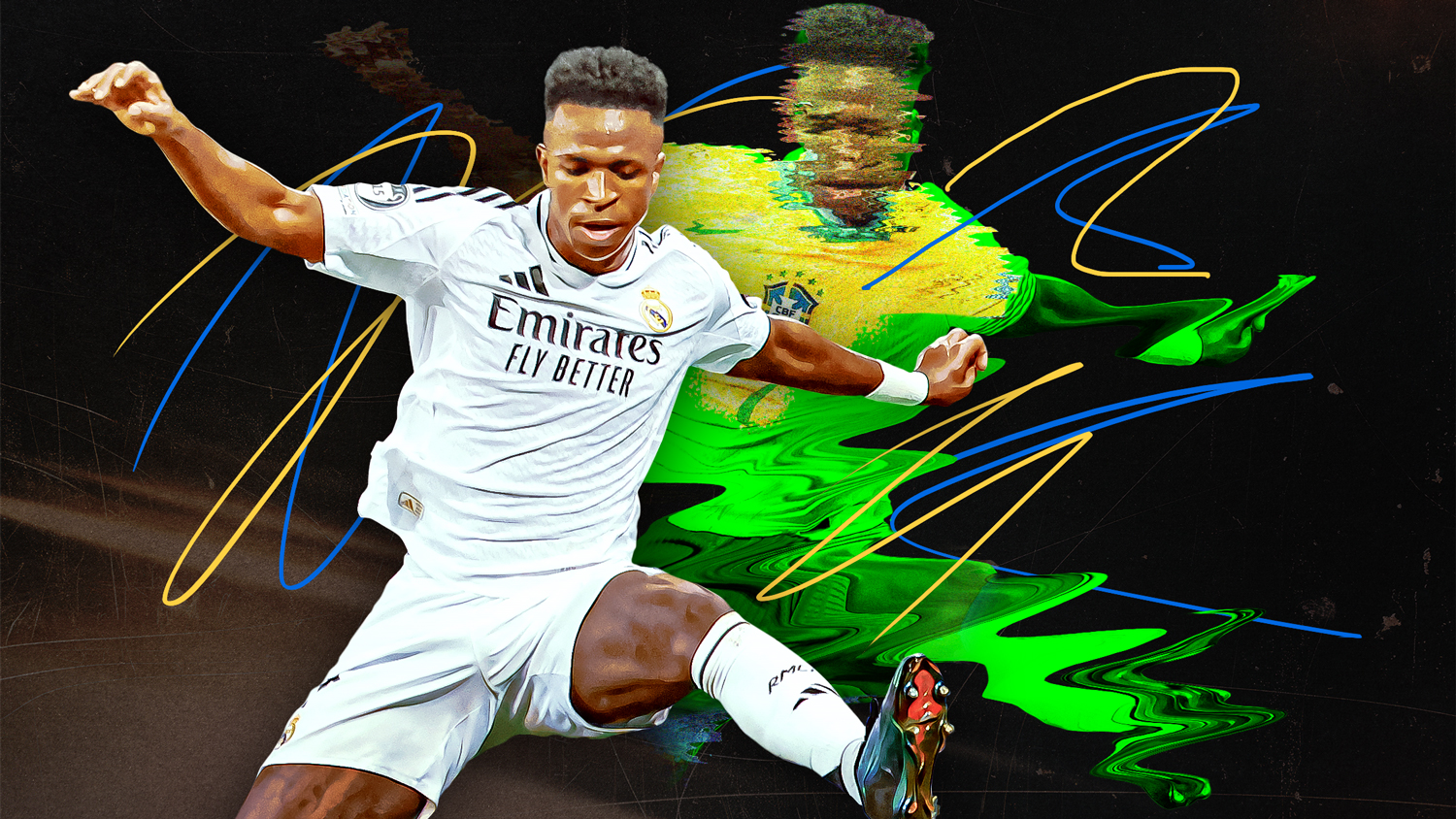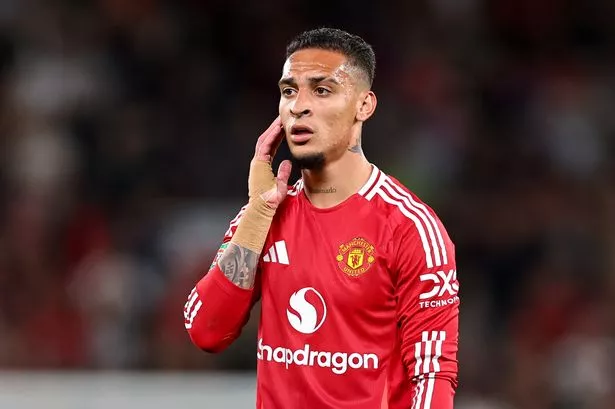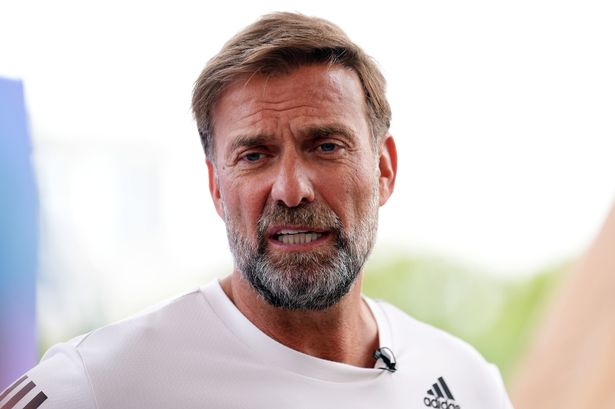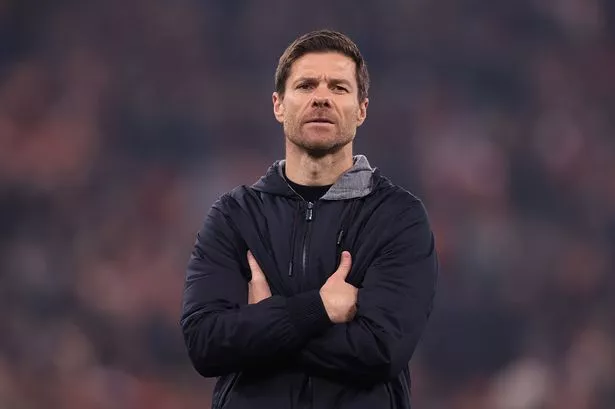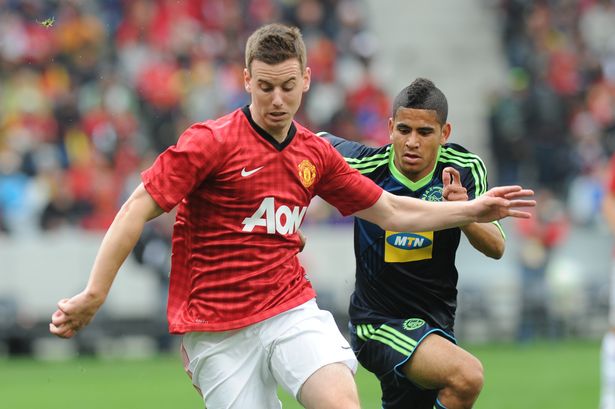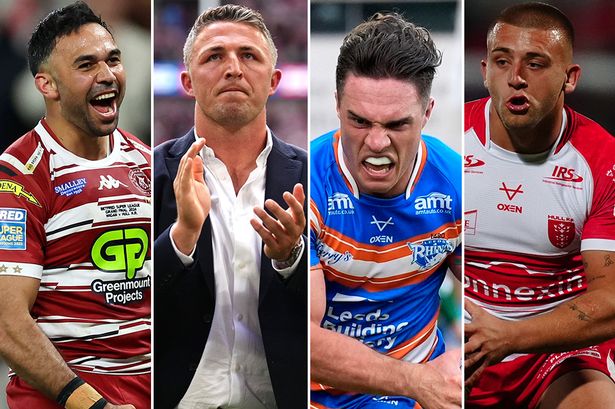Vinícius is stellar for Madrid and is reaching his peak. So why has he not yet been able to translate his club form and status into success with Brazil?
Vinícius is stellar for Madrid and is reaching his peak. So why has he not yet been able to translate his club form and status into success with Brazil? Vinícius is stellar for Madrid and is reaching his peak. So why has he not yet been able to translate his club form and status into success with Brazil?
Additional reporting by Gustavo Hofman.
Vinícius Júnior didn’t win the Ballon d’Or last month, but try telling Real Madrid fans that he didn’t deserve it. “Vinícius, Ballon d’Or,” the crowd at the Santiago Bernabeu sang on Saturday, over and over again, as the forward scored a hat trick in Madrid’s 4-0 LaLiga win over Osasuna.
It was Vinícius’ second Bernabeu hat trick in just 2½ weeks. On Oct. 22, against Borussia Dortmund in the Champions League, he scored three times in the second half, helping Madrid secure a 5-2 comeback. The performance had journalists in the Bernabeu press box asking if this was the best 45 minutes of Vinícius’ career to date.
And it’s not just the fans, or the media. Jude Bellingham called Vinícius “unstoppable” after the Osasuna game. “He’s a leader for us,” Bellingham said. Madrid coach Carlo Ancelotti has no doubts, either. He first called Vinícius “the best in the world” in February this year, after he scored once, and created two more, in a 4-0 league win over Girona.
Vinícius’ numbers for his club are impressive. This season, he already has 12 goals in 17 Madrid games in all competitions. Last year, he scored 24 times, including in the Champions League final. But that wasn’t enough to convince the Ballon d’Or jury that he’s the world’s best.
Details of the voting for the 2024 men’s prize — released last weekend — show Vinícius received 1,129 points. Manchester City‘s Rodri earned 1,170. Out of a 100-strong panel of international journalists, 35 thought Vinícius was number one. But 49 thought the same about Rodri. Madrid’s displeasure at the verdict saw them boycott the ceremony.
What more can Vinícius do to win over the sceptics? A frequent criticism has been his widely perceived underperformance with his national team, Brazil. For his country, he has rarely been the decisive figure we’re used to seeing in Madrid. More often, his displays have been divisive.
In five years playing for his country, Vinícius has only scored five goals. Two of them came in one game, at last summer’s Copa América. And while Vinícius underwhelmed at that tournament, Ballon d’Or rival Rodri was leading Spain to glory at Euro 2024.
Vinícius is now 24 years old and approaching his peak. So why has he not yet been able to translate his Real Madrid form, and status, into international success with Brazil? With the 2026 World Cup on the horizon, is there any sign of that changing anytime soon? — Alex Kirkland
From raw youngster to breakthrough player and now a club star
Vinícius arrived in Madrid as a raw youngster in July 2018, joining from Brazil’s Flamengo when he turned 18. It was a bold, €45 million deal for an unproven teenager. In the six years since, he’s been transformed as a player and as a person. He’s now a global superstar, a Ballon d’Or contender, an anti-racism campaigner and a UNESCO ambassador.
On the pitch, his early years at Madrid were inconsistent. His natural talent was evident — notably, his explosive pace and dribbling — but so were his weaknesses, particularly his wayward finishing. Critics mocked his ability in front of goal. In his first three seasons at Real Madrid, his goal tallies in LaLiga were two, three and three.
“For me, it’s simple with Vinícius: it’s time, and playing football,” former Madrid coach Santi Solari — who first gave Vinícius a regular spot in the team in 2018-19, and is now the club’s director of football — said in Nov. 2018. “He has so much time ahead of him, he’s barely 18. Experience will make him a better player. And of course, we all see that talent he has, that’s obvious.”
A defining characteristic has been Vinícius’ relentless work ethic, and his desire to improve. He won over Solari, and eventually his successor Zinedine Zidane. His first truly eye-catching performance at the highest level came in the 2020-21 Champions League, scoring twice against Liverpool in a 3-1 win. His first goal, using his pace to latch onto a quarterback-style pass from Toni Kroos and finish confidently, was a prelude for what was to follow.
Vinícius’ breakthrough season for Madrid came in 2021-22, coinciding with Ancelotti’s arrival as coach.
Ancelotti’s advice in August 2021 was straightforward. “He has a lot of quality in one-on-ones,” Ancelotti said, when asked about Vinícius’ finishing. “I’ve told him he has to score with one or two touches. It’s harder to score after taking three or four. You have to be there, inside the box.”
The message was clear: play closer to goal. Take fewer touches. Finish instinctively.
His goalscoring took a qualitative and quantitative leap that he’s yet to manage for Brazil. A comparison between Vinícius’ LaLiga statistics in 2020-21 and 2021-22 highlights just how quickly he improved. In both seasons, he featured in 35 league games — 22 and 30, respectively, as a starter.
In 2021-22, he took 80 shots, *twice* as many as his 40 in the previous campaign. His percentage of shots on target rocketed from 32.5% to 53.8%. His expected goals almost doubled, from 6.47 to 12.35, and he went from underperforming that xG (with three goals in 2020-21) to overperforming (with 17 goals in 2021-22).
The result: Madrid won a LaLiga and Champions League double in 2022. In the Champions League final in Paris, Vinícius scored in a 1-0 win over LiverpooL. In 2022-23, there were more contenders for career-best performance — many would point to a 5-2 win at Anfield in February 2023, when Vinícius scored twice and created another — but the next leap forward in his development came in 2023-24, after Karim Benzema had left the club.
Instead of playing wide left in a front three, Vinícius would form an unconventional front two made up of two wide forwards and no central striker, alongside fellow Brazilian Rodrygo, with Bellingham behind them. A look at the heat maps for Vinícius’ last LaLiga season before Ancelotti’s arrival, 2020-21, and his most recent full season, 2023-24, shows a shift in his positioning, into the penalty area, and closer to goal.
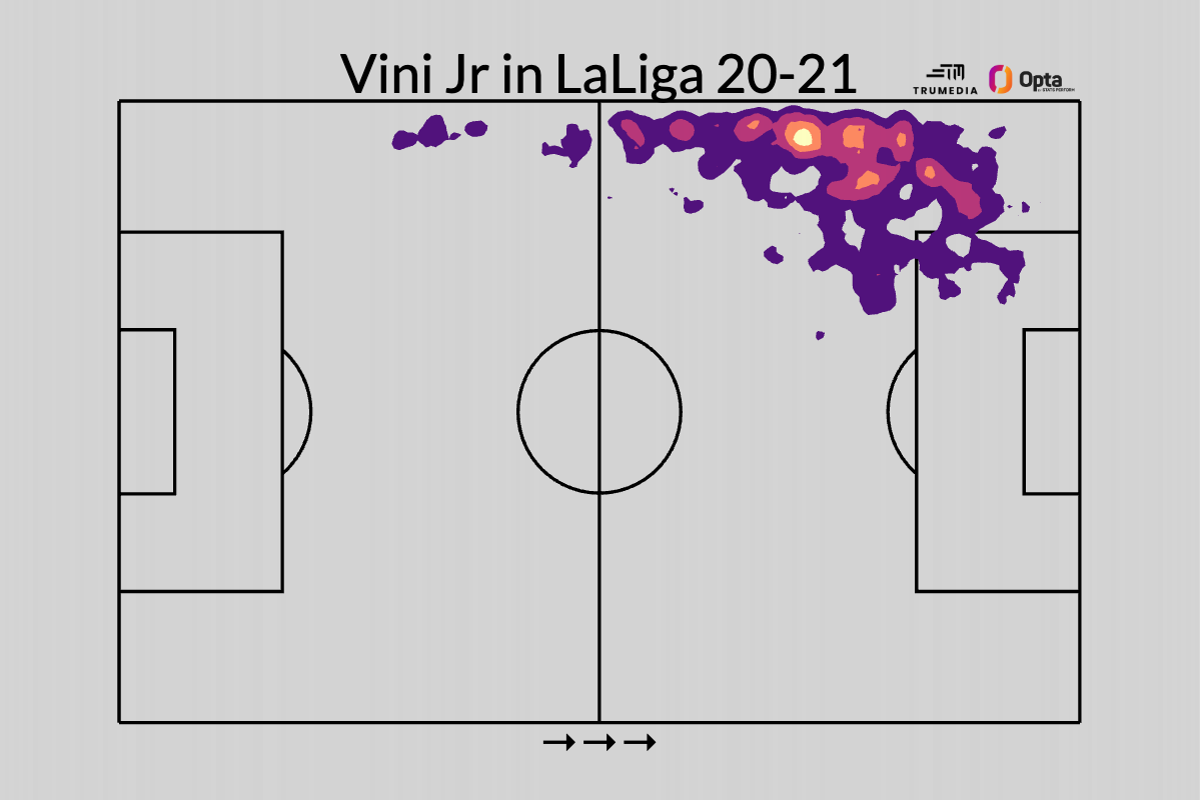
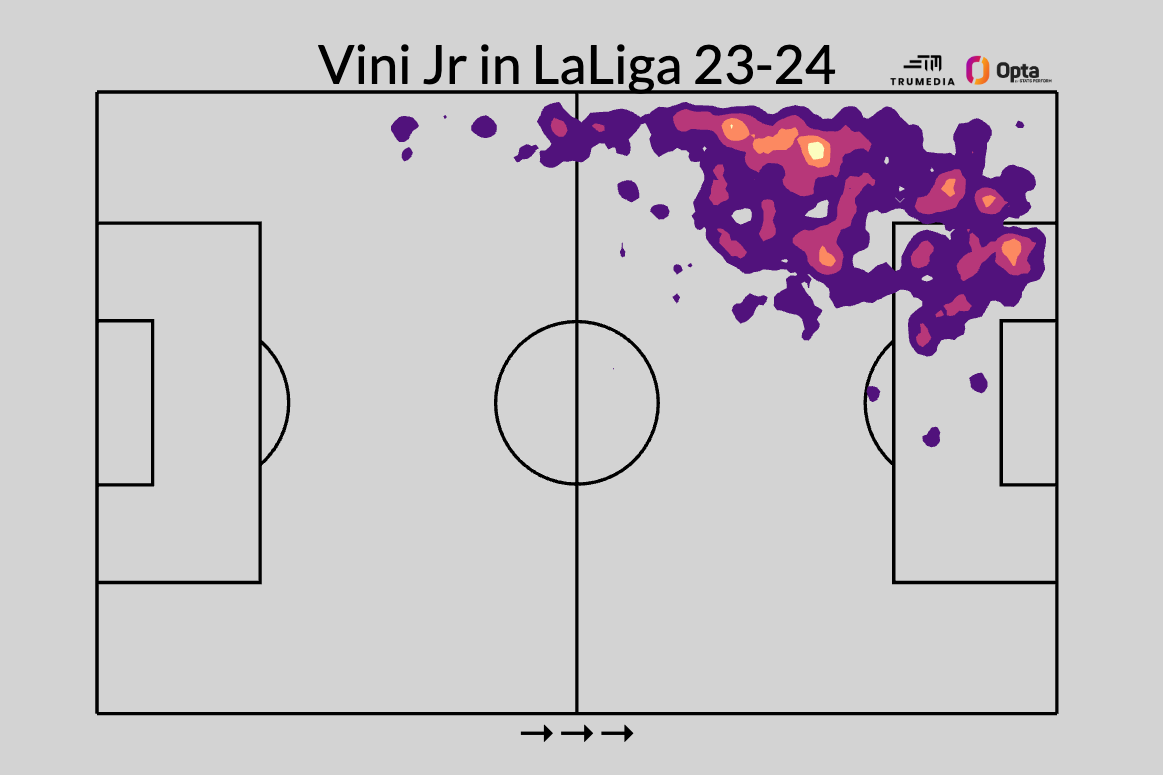
In 2024, Vinícius led Madrid to a LaLiga and Champions League double once again, and scored in the Champions League final. The strike which best illustrated his progression came earlier, though, in Madrid’s semifinal first leg against Bayern Munich on April 30. Vinícius dropped deep, pulling centre-back Kim Min-Jae out of position, before spinning and bursting into the space created behind the defender, shooting first-time past goalkeeper Manuel Neuer. This wasn’t the finish of a converted winger; Vinícius looked a true centre-forward.
The long-awaited arrival of Kylian Mbappé this past summer has slowed that trend somewhat, with Vinícius often returning to occupy his position on the left-wing, although the pair have also lined up as a front two. After a slow start to 2024-25, Vinícius is now flying. If losing out to Rodri for the Ballon d’Or was a setback, Vinícius has responded in the best way possible, scoring in both games since, against AC Milan and Osasuna.
He celebrated his first goal against Osasuna by running to the touchline and embracing Ancelotti. A source close to the player told ESPN that Vinícius had been unhappy with the pressure his coach has come under in recent weeks — after losses to Barcelona and Milan — and wanted to offer a public show of support for the man he views as a mentor, and the manager who has known how to get the best out of him.
Mbappé’s presence means Vinícius must vie for attention in attack, but the stats this season show that Vinícius has been the better player. Vinícius has scored more league goals (eight to Mbappé’s six) and created more chances (24 to Mbappé’s 13). Vinícius’ shot conversion rate is 21.6%, to Mbappé’s 11.5%. Out of possession, the difference is even greater. Vinícius has made 11 tackles to Mbappé’s one, with a total of 42 defensive interventions (which include recoveries, tackles, interceptions and clearances) to Mbappé’s 17.
Despite the arrival of Mbappé — and the presence of another superstar like Bellingham — Vinícius is still the main man for Real Madrid, arguably the world’s biggest club, and has been for multiple seasons now. It makes his failure to convince for Brazil all the more puzzling. — Kirkland
García: Vinícius was unstoppable for Real Madrid vs. Osasuna
Luis García reacts to Vinícius Júnior’s hat trick performance for Real Madrid against Osasuna.
Why is Vini struggling for Brazil?
When Brazil coach Dorival Junior called up his squad for the November games against Venezuela and Uruguay, he was inevitably drawn into the great Ballon D’Or debate. He referred to Vinícius coming in second as “an unfair situation.
“If there was one decisive, lethal player whose talent was on display to the whole world,” he continued, “it was him. Maybe the biggest prize that Vinícius won was the recognition and respect of his people. The vast majority of the Brazilian people were aware that an injustice had taken place.”
But the last time that Vinícius played for Brazil, the vast majority of his compatriots did not seem too pleased with him. The team fell to a dismal defeat away to Paraguay, and he made little impression. Paraguay coach Gustavo Alfaro trusted in his right-back Juan Caceres and midfielder Mathías Villasanti to shut down Vini. Despite the Brazilians feeding Vini, he had no space to work.
A Rodrygo dribble opened up the defence, but left Vinícius with an angle too narrow for a dangerous shot. Just once he was able to cut in and unleash a shot, turned round the post by the goalkeeper. It was a frustrating evening, all pumped up effort and little end product.
TV pundits were calling for Vinícius to be substituted, expressing a widespread impatience — which a total of just five goals in 35 internationals goes some way to explain.
Vinícius first played for his country more than five years ago, but it is since the 2021 Copa América that he has been a permanent part of the squad. Then-coach Tite says that it took him time to find his feet in the national team.
At first, he was a substitute. Given his first start, away to Chile in a Sept. 2021 World Cup qualifier, he was taken off at half time, and subsequently returned to the bench. He forced his way back in as a consequence of excellent club form, but he was always something of a bolt-on.
Tite’s team played its best football with one out and out winger, Raphinha on the right, and Lucas Paquetá operating as a false left winger, cutting in to combine with Neymar. Right up until the first match of the 2022 Qatar World Cup, Brazil’s coaching staff was wrestling with a dilemma. The choice was either Fred, with Paquetá as a winger, or Vinícius, with Paquetá in midfield. In the end, they could not leave Vinícius out, and they were not disappointed. In Qatar, he produced his best international displays to that date.
He set up both goals in the opening 2-0 win over Serbia, and the only goal in the win over Switzerland. He put them on the path to a comfortable second victory over South Korea with the first goal, a cute shot back across the goal, and set up Paquetá for the strike that put Brazil four ahead before half time.
Vinícius had his moments in the fatal quarterfinal against Croatia, but was taken off soon after the hour mark, with the coaching staff worried that he was not pressing well enough, and the opponents were finding it too easy to get the ball to Luka Modric. Even so, Vinícius came out of the tournament as one of Brazil’s plus points. He had shown beyond all doubt that he belonged at the level.
Now, Vinícius is no longer a bolt-on for Brazil, and adds a bit of extra spice. Especially since the long term injury to Neymar, he is expected to be the team’s most potent attacking weapon. The plan is now built around him – but he has been an ineffective figure in humiliating games such as a draw at home to Venezuela, plus defeats to Uruguay and Paraguay, and a disappointing Copa América.
So where is the problem?
Does Ancelotti regret turning down Brazil? ‘You make me laugh!’
Carlo Ancelotti bites back at questions in his press conference after back-to-back defeats for Real Madrid.
Given the outcome of the Ballon D’Or vote, it contains a delicious irony. There is a type of player badly lacking in the Brazil lineup — one with the characteristics of a Rodri.
Vinícius is primarily a winger. As a general rule, the game cannot be won down the flanks without first winning the midfield battle. Without intelligent passing to take opponents out of the game, a player like Vinícius has a tough task. He has a restricted corridor in which to operate – -and the opposition are waiting for him, ganging up to deny him space. This has even been a problem with Real Madrid this season after the retirement of Toni Kroos, his main supply line.
Following Real Madrid’s first game in this season’s Champions League, against Lille of France, Predrag Mijatovic, the club’s former star, declared his concern. “Real Madrid’s midfield at the moment, ” he told the Spanish media, “has a lot of physical strength but not enough creativity. I missed Modric tonight and, unfortunately, Toni Kroos is no longer available.
“Everyone is talking about Vini losing form, but his style of play depends on how the ball reaches him. Against Lille the midfield was not creative enough to give him useful passes, the kind of service he needs to pull off his characteristic moves,” Mijatovic added.
Real Madrid’s midfield problem this season has been a consistent problem in the Brazilian national team.
Newcastle’s Bruno Guimarães has perhaps been the biggest disappointment over the past year in efforts to solve this positional crisis. Since Casemiro was dropped, Guimarães has supposedly been the king of the midfield, but has yet to rise to the challenge. Paquetá in a deeper role offers a possible solution — he combined superbly with Vinícius for a goal against Paraguay in the Copa América — but his form has been wayward.
Other countries would love to have Brazil’s goalkeepers, centre-backs and wingers, but for years now there has been a dearth of all-round midfielders. The separation, so prominent in the 90s, of the Brazilian midfield into those who only defend and those who only attack continues to cast a shadow. There is no one to control the midfield, to push and pull the opposition this way and that, to open up the space — and then slip the pass to Vinícius. — Tim Vickery
Is there a solution to the Brazil problem?
Dorival Junior is putting his faith in time and temperance. As he gets used to his new job and spends more time on the training field, he hopes that things will flow better.
In the short term, Vinícius can count on increased public support. Injury kept him out of last month’s games — wins against Chile and Peru, the weakest teams in the competition which boosted morale and eased any residual fears of failing to qualify for 2026.
With ten of the 18 rounds played, Brazil now lie in fourth position — up from sixth two months ago. With six sides making it through automatically and a seventh going into a play-off, there would not seem to be the slightest chance of them missing out.
So if the fans were ready to get on Vinícius’ back in September, come November they will be in the mood to get behind him in the wake of the Ballon D’Or controversy.
How the football world reacted to Vinicius Junior’s Ballon d’Or snub
ESPN FC’s analysts and players sound off after Real Madrid declined to attend the Ballon d’Or ceremony upon finding out that Manchester City’s Rodri won.
There has been a significant development during his short absence, too — the appearance of a centre-forward. Surprisingly, this has been a problem position for a while. Brazil recently tried to get round it with a move from the Ancelotti playbook. In the season after Benzema and before Mbappé, Real had Vinícius attack the vacant space in the centre-forward slot. The player said that it was the season in which he had learned most, and it was only natural for Brazil to attempt to get him to do the same thing with the national team.
But it is not easy to play without a focal point up front. Doing without a number nine is far easier for a club, with extended time to train, than it is for a national team. Brazil were unable to get it to work. A struggling midfield — and Brazil’s was most certainly that — benefits immensely from the option of playing up to a centre-forward who can hold on to the ball. Brazil were unable to play their way down the pitch, and when they went long, as they often did with no one to receive, they usually ended up surrendering possession.
But then came the extraordinary rise of Igor Jesus, in yet another remarkable coup for Botafogo’s scouting department. A few months ago, Jesus was a relative unknown playing in the United Arab Emirates. Botafogo signed him in July, and by October he was the national team’s first choice centre-forward. Strong and mobile, he adds all kinds of attacking possibilities. Vinícius is now set to team up with him for the first time, planting the seeds of what could be an important partnership for the national team.
And in an uncharacteristic act of bravado, coach Dorival Junior recently promised that his side will be playing in the 2026 World Cup final. Turning words into deeds will prove much easier if the best Vinícius Júnior in the white of Real Madrid can also show his face and his feet in the famous yellow of Brazil. — Vickery
www.espn.com – SOCCER
